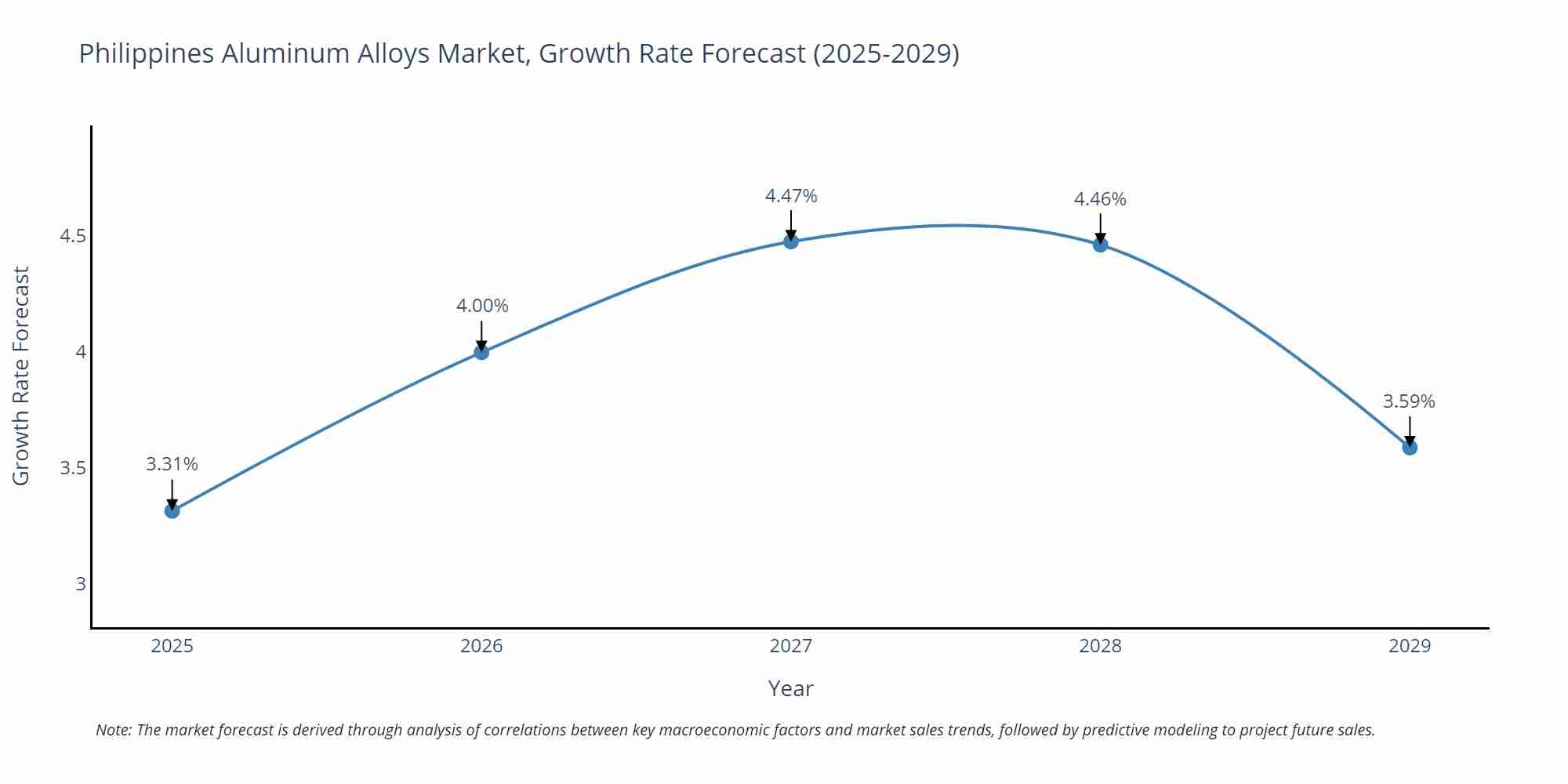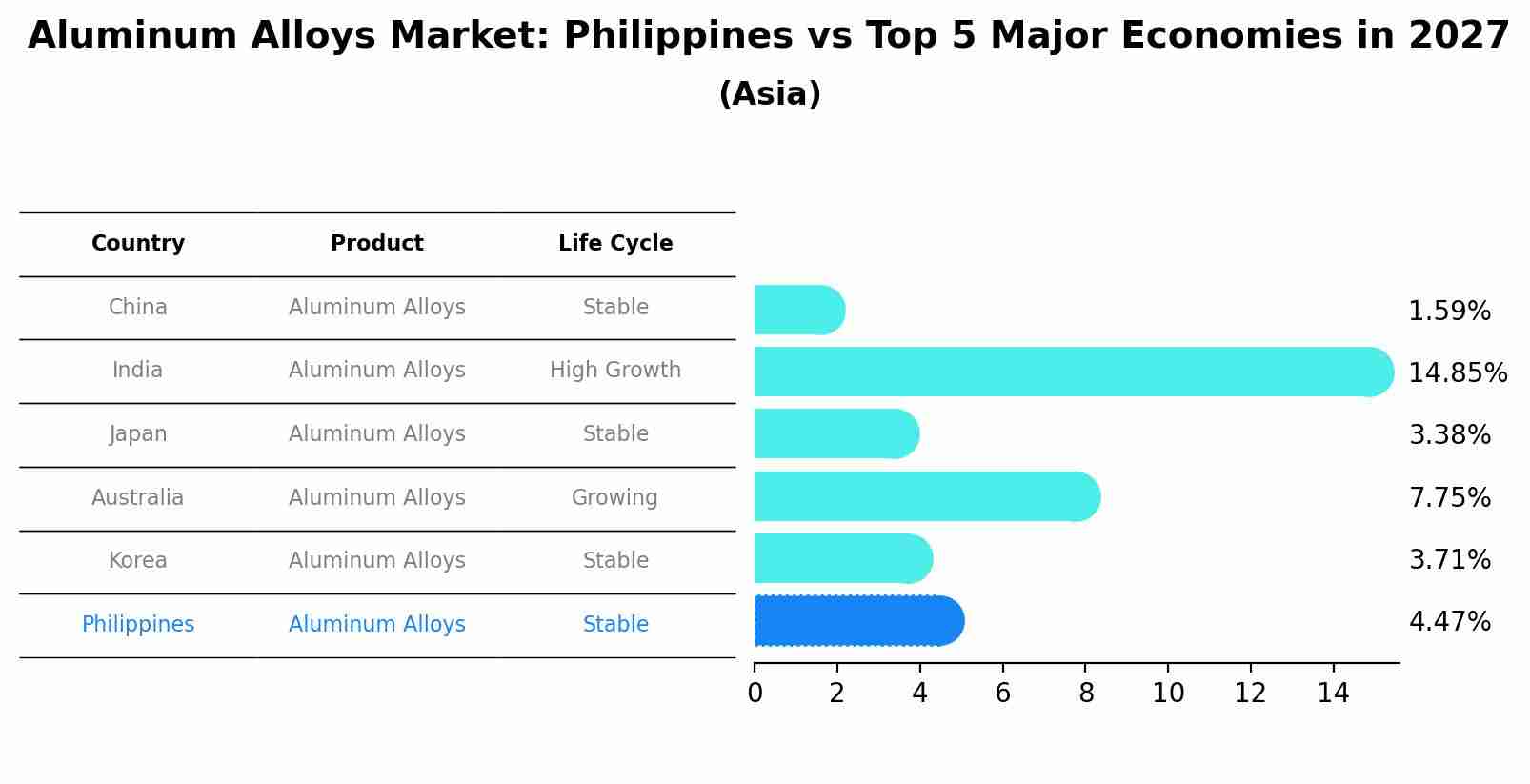Philippines Aluminum Alloys Market (2025-2031) Outlook | Value, Forecast, Size, Share, Growth, Industry, Trends, Analysis, Companies, Revenue
| Product Code: ETC249269 | Publication Date: Aug 2022 | Updated Date: Aug 2025 | Product Type: Market Research Report | |
| Publisher: 6Wresearch | No. of Pages: 75 | No. of Figures: 35 | No. of Tables: 20 | |
Philippines Aluminum Alloys Market Size Growth Rate
The Philippines Aluminum Alloys Market is projected to witness mixed growth rate patterns during 2025 to 2029. Starting at 3.31% in 2025, the market peaks at 4.47% in 2027, and settles at 3.59% by 2029.

Aluminum Alloys Market: Philippines vs Top 5 Major Economies in 2027 (Asia)
In the Asia region, the Aluminum Alloys market in Philippines is projected to expand at a stable growth rate of 4.47% by 2027. The largest economy is China, followed by India, Japan, Australia and South Korea.

philippines aluminum based strips market Synopsis
In the Philippines, the market for aluminum-based strips has gained substantial traction in recent years. Market data reveals a notable CAGR of around 5% over the past five years. This growth can be attributed to the versatile applications of aluminum strips across industries such as electronics, packaging, and consumer goods. The lightweight nature and excellent formability of aluminum strips make them ideal for use in various product designs. The electronics sector, in particular, has witnessed a surge in demand due to the increasing use of aluminum strips in electronic components and devices. As the manufacturing sector continues to evolve, the aluminum-based strips market is poised to capitalize on emerging opportunities.
Drivers of the Market
The Philippines aluminum-based strips market is on a growth trajectory due to several driving factors. The construction and manufacturing industries are key drivers, as aluminum strips find use in various applications such as roofing, cladding, electrical components, and consumer electronics. The lightweight nature of aluminum, coupled with its excellent conductivity and corrosion resistance, makes it a preferred material for these applications. The expanding electronics and electrical sectors, driven by technological advancements and urbanization, are expected to fuel the demand for aluminum strips in wiring and electronic components. Furthermore, the trend towards energy efficiency and sustainability will lead to increased use of aluminum strips in solar panels and other renewable energy applications.
Challenges of the Market
The Philippines aluminum-based strips market encounters certain challenges that influence its trajectory. Fluctuations in the supply and cost of raw materials, such as aluminum ingots, impact the profitability of manufacturers. The market`s growth is also influenced by competition from other materials like steel or plastics, necessitating strategies to promote the advantages of aluminum strips. Additionally, maintaining consistent product quality and meeting international standards is essential, requiring investments in quality control measures. Economic uncertainties and changes in consumer preferences can also pose challenges, demanding adaptability from market players.
COVID-19 Impact on the Market
The COVID-19 pandemic had a mixed impact on the Philippines aluminum-based strips market. While the disruption in supply chains and manufacturing activities initially affected the production and distribution of these strips, the market saw a revival as industries adapted to the new normal. The demand for aluminum-based strips, used in various applications including electronics, packaging, and automotive, experienced fluctuations throughout the pandemic. Remote work trends boosted the electronics sector, positively affecting the demand for aluminum-based strips used in electronic components. However, challenges persisted due to uncertainties in global markets and supply chain disruptions.
Key Players in the Market
The aluminum strips market in the Philippines is thriving due to the demand for lightweight and corrosion-resistant materials in various applications, including packaging, electronics, and construction. Leading players like AluStrip Solutions, MetalFlex Industries, and StripMasters Corp play a vital role in meeting these demands. These companies are known for their advanced manufacturing processes, product innovation, and commitment to environmental sustainability.
Key Highlights of the Report:
- Philippines Aluminum Alloys Market Outlook
- Market Size of Philippines Aluminum Alloys Market, 2024
- Forecast of Philippines Aluminum Alloys Market, 2031
- Historical Data and Forecast of Philippines Aluminum Alloys Revenues & Volume for the Period 2021-2031
- Philippines Aluminum Alloys Market Trend Evolution
- Philippines Aluminum Alloys Market Drivers and Challenges
- Philippines Aluminum Alloys Price Trends
- Philippines Aluminum Alloys Porter's Five Forces
- Philippines Aluminum Alloys Industry Life Cycle
- Historical Data and Forecast of Philippines Aluminum Alloys Market Revenues & Volume By Process for the Period 2021-2031
- Historical Data and Forecast of Philippines Aluminum Alloys Market Revenues & Volume By Die Casting for the Period 2021-2031
- Historical Data and Forecast of Philippines Aluminum Alloys Market Revenues & Volume By Sand Casting for the Period 2021-2031
- Historical Data and Forecast of Philippines Aluminum Alloys Market Revenues & Volume By Permanent Mold Casting for the Period 2021-2031
- Historical Data and Forecast of Philippines Aluminum Alloys Market Revenues & Volume By End-use for the Period 2021-2031
- Historical Data and Forecast of Philippines Aluminum Alloys Market Revenues & Volume By Transportation sector for the Period 2021-2031
- Historical Data and Forecast of Philippines Aluminum Alloys Market Revenues & Volume By Building & Construction sector for the Period 2021-2031
- Historical Data and Forecast of Philippines Aluminum Alloys Market Revenues & Volume By Industrial sector for the Period 2021-2031
- Historical Data and Forecast of Philippines Aluminum Alloys Market Revenues & Volume By Others for the Period 2021-2031
- Philippines Aluminum Alloys Import Export Trade Statistics
- Market Opportunity Assessment By Process
- Market Opportunity Assessment By End-use
- Philippines Aluminum Alloys Top Companies Market Share
- Philippines Aluminum Alloys Competitive Benchmarking By Technical and Operational Parameters
- Philippines Aluminum Alloys Company Profiles
- Philippines Aluminum Alloys Key Strategic Recommendations
Frequently Asked Questions About the Market Study (FAQs):
1 Executive Summary |
2 Introduction |
2.1 Key Highlights of the Report |
2.2 Report Description |
2.3 Market Scope & Segmentation |
2.4 Research Methodology |
2.5 Assumptions |
3 Philippines Aluminum Alloys Market Overview |
3.1 Philippines Country Macro Economic Indicators |
3.2 Philippines Aluminum Alloys Market Revenues & Volume, 2021 & 2031F |
3.3 Philippines Aluminum Alloys Market - Industry Life Cycle |
3.4 Philippines Aluminum Alloys Market - Porter's Five Forces |
3.5 Philippines Aluminum Alloys Market Revenues & Volume Share, By Process, 2021 & 2031F |
3.6 Philippines Aluminum Alloys Market Revenues & Volume Share, By End-use, 2021 & 2031F |
4 Philippines Aluminum Alloys Market Dynamics |
4.1 Impact Analysis |
4.2 Market Drivers |
4.2.1 Growing demand from the construction and automotive industries in the Philippines. |
4.2.2 Increasing focus on lightweight and durable materials in manufacturing processes. |
4.2.3 Government initiatives to promote the use of aluminum alloys in various sectors. |
4.3 Market Restraints |
4.3.1 Fluctuating raw material prices impacting production costs. |
4.3.2 Competition from alternative materials such as steel and composites. |
4.3.3 Lack of domestic production capabilities leading to dependence on imports. |
5 Philippines Aluminum Alloys Market Trends |
6 Philippines Aluminum Alloys Market, By Types |
6.1 Philippines Aluminum Alloys Market, By Process |
6.1.1 Overview and Analysis |
6.1.2 Philippines Aluminum Alloys Market Revenues & Volume, By Process, 2021-2031F |
6.1.3 Philippines Aluminum Alloys Market Revenues & Volume, By Die Casting, 2021-2031F |
6.1.4 Philippines Aluminum Alloys Market Revenues & Volume, By Sand Casting, 2021-2031F |
6.1.5 Philippines Aluminum Alloys Market Revenues & Volume, By Permanent Mold Casting, 2021-2031F |
6.2 Philippines Aluminum Alloys Market, By End-use |
6.2.1 Overview and Analysis |
6.2.2 Philippines Aluminum Alloys Market Revenues & Volume, By Transportation sector, 2021-2031F |
6.2.3 Philippines Aluminum Alloys Market Revenues & Volume, By Building & Construction sector, 2021-2031F |
6.2.4 Philippines Aluminum Alloys Market Revenues & Volume, By Industrial sector, 2021-2031F |
6.2.5 Philippines Aluminum Alloys Market Revenues & Volume, By Others, 2021-2031F |
7 Philippines Aluminum Alloys Market Import-Export Trade Statistics |
7.1 Philippines Aluminum Alloys Market Export to Major Countries |
7.2 Philippines Aluminum Alloys Market Imports from Major Countries |
8 Philippines Aluminum Alloys Market Key Performance Indicators |
8.1 Average selling price of aluminum alloys in the Philippines market. |
8.2 Percentage of aluminum alloy usage in key industries like construction and automotive. |
8.3 Number of new government policies supporting the adoption of aluminum alloys in the Philippines. |
9 Philippines Aluminum Alloys Market - Opportunity Assessment |
9.1 Philippines Aluminum Alloys Market Opportunity Assessment, By Process, 2021 & 2031F |
9.2 Philippines Aluminum Alloys Market Opportunity Assessment, By End-use, 2021 & 2031F |
10 Philippines Aluminum Alloys Market - Competitive Landscape |
10.1 Philippines Aluminum Alloys Market Revenue Share, By Companies, 2024 |
10.2 Philippines Aluminum Alloys Market Competitive Benchmarking, By Operating and Technical Parameters |
11 Company Profiles |
12 Recommendations |
13 Disclaimer |
- Single User License$ 1,995
- Department License$ 2,400
- Site License$ 3,120
- Global License$ 3,795
Search
Related Reports
- ASEAN Bearings Market (2025-2031) | Strategy, Consumer Insights, Analysis, Investment Trends, Opportunities, Growth, Size, Share, Industry, Revenue, Segments, Value, Segmentation, Supply, Forecast, Restraints, Outlook, Competition, Drivers, Trends, Demand, Pricing Analysis, Competitive, Strategic Insights, Companies, Challenges
- Europe Flooring Market (2025-2031) | Outlook, Share, Industry, Trends, Forecast, Companies, Revenue, Size, Analysis, Growth & Value
- Saudi Arabia Manlift Market (2025-2031) | Outlook, Size, Growth, Trends, Companies, Industry, Revenue, Value, Share, Forecast & Analysis
- Uganda Excavator, Crane, and Wheel Loaders Market (2025-2031) | Strategy, Consumer Insights, Analysis, Investment Trends, Opportunities, Growth, Size, Share, Industry, Revenue, Segments, Value, Segmentation, Supply, Forecast, Restraints, Outlook, Competition, Drivers, Trends, Demand, Pricing Analysis, Competitive, Strategic Insights, Companies, Challenges
- Rwanda Excavator, Crane, and Wheel Loaders Market (2025-2031) | Strategy, Consumer Insights, Analysis, Investment Trends, Opportunities, Growth, Size, Share, Industry, Revenue, Segments, Value, Segmentation, Supply, Forecast, Restraints, Outlook, Competition, Drivers, Trends, Demand, Pricing Analysis, Competitive, Strategic Insights, Companies, Challenges
- Kenya Excavator, Crane, and Wheel Loaders Market (2025-2031) | Strategy, Consumer Insights, Analysis, Investment Trends, Opportunities, Growth, Size, Share, Industry, Revenue, Segments, Value, Segmentation, Supply, Forecast, Restraints, Outlook, Competition, Drivers, Trends, Demand, Pricing Analysis, Competitive, Strategic Insights, Companies, Challenges
- Angola Excavator, Crane, and Wheel Loaders Market (2025-2031) | Strategy, Consumer Insights, Analysis, Investment Trends, Opportunities, Growth, Size, Share, Industry, Revenue, Segments, Value, Segmentation, Supply, Forecast, Restraints, Outlook, Competition, Drivers, Trends, Demand, Pricing Analysis, Competitive, Strategic Insights, Companies, Challenges
- Israel Intelligent Transport System Market (2025-2031) | Strategy, Consumer Insights, Analysis, Investment Trends, Opportunities, Growth, Size, Share, Industry, Revenue, Segments, Value, Segmentation, Supply, Forecast, Restraints, Outlook, Competition, Drivers, Trends, Demand, Pricing Analysis, Competitive, Strategic Insights, Companies, Challenges
- Uganda Precast and Aggregate Market (2025-2031) | Strategy, Consumer Insights, Analysis, Investment Trends, Opportunities, Growth, Size, Share, Industry, Revenue, Segments, Value, Segmentation, Supply, Forecast, Restraints, Outlook, Competition, Drivers, Trends, Demand, Pricing Analysis, Competitive, Strategic Insights, Companies, Challenges
- Australia IT Asset Disposal Market (2025-2031) | Strategy, Consumer Insights, Analysis, Investment Trends, Opportunities, Growth, Size, Share, Industry, Revenue, Segments, Value, Segmentation, Supply, Forecast, Restraints, Outlook, Competition, Drivers, Trends, Demand, Pricing Analysis, Competitive, Strategic Insights, Companies, Challenges
Industry Events and Analyst Meet
Our Clients
Whitepaper
- Middle East & Africa Commercial Security Market Click here to view more.
- Middle East & Africa Fire Safety Systems & Equipment Market Click here to view more.
- GCC Drone Market Click here to view more.
- Middle East Lighting Fixture Market Click here to view more.
- GCC Physical & Perimeter Security Market Click here to view more.
6WResearch In News
- Doha a strategic location for EV manufacturing hub: IPA Qatar
- Demand for luxury TVs surging in the GCC, says Samsung
- Empowering Growth: The Thriving Journey of Bangladesh’s Cable Industry
- Demand for luxury TVs surging in the GCC, says Samsung
- Video call with a traditional healer? Once unthinkable, it’s now common in South Africa
- Intelligent Buildings To Smooth GCC’s Path To Net Zero













